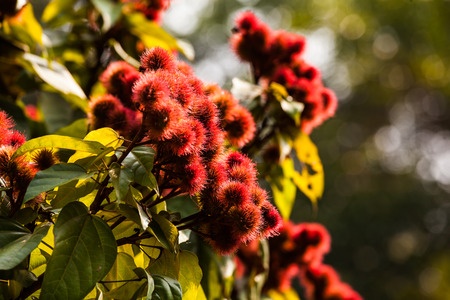Achiote - Bixa orellana

Common Names: Achiote, Annatto, Lipstick Tree, Uruku, Aploppas, Bixa orellana, Bixin tree, Roucou, Arnatto, Urucum, Culantrillo, Atachuti, Colorau, Achuete
Latin Name: Bixa orellana
Origin: Asia, South America
Short Introduction
The achiote plant, known by many names, bears a Latin name derived from "biche," the Portuguese word describing the shape of its fruit, and "orellana" in honor of the Spanish explorer who discovered the Amazon region. Although the fruit of the achiote is inedible, the plant is cultivated for its seeds. Historically, achiote was used by Indigenous groups such as the Maya and Aztecs predominantly as a dye and in religious rituals, as the color closely resembled blood.
The achiote plant is native to the areas surrounding the Amazon River and other rivers in the tropical parts of South and Central America, making cultivation outside of equatorial tropical regions challenging. Today, achiote is grown in tropical zones around the equator. See the section 'Origin and Distribution' for more details.
Detailed Description
A healing plant from the Amazon rainforest, used for various ailments.
Botanical Information
Achiote is a species of shrub or classic tropical tree naturally found in the tropical belt of South America. It can grow to heights exceeding 20 meters, though it is typically 5–10 meters tall. The plant features pale pinkish-white blossoms that develop into heart-shaped, light-red fruit—not edible. When the fruit, or capsule, is opened, it reveals numerous seeds embedded in orange pulp. A single plant can yield an abundant harvest, up to 270 kg of fruit per season.
The plant is most commonly cultivated for annatto (also called "bixin"), a dye extracted by boiling the seeds in water. Annatto is used to color cheeses, fish, and as a spice and coloring in a variety of traditional dishes like cochinita pibil, rice, and meats. Bolivia, Brazil, Colombia, Ecuador, India, and Jamaica are the largest producers. Annatto is sold as a paste or powder for culinary use under regional names such as "achiote," "annatto," or "bijol." In traditional cuisines, achiote has been used both as a colorant and flavoring agent, often as a substitute for the more expensive and less accessible saffron. In Mexico, it is a key ingredient in tascalate, a drink originating from Chiapas. In Scandinavia and the UK, achiote pigment is added as a colorant to margarine and other foods. Internationally, this natural coloring is labeled as E160b—making it a prime example of a beneficial "E-number" (another example being vitamin C). Unfortunately, some manufacturers prefer beta-carotene, which is more expensive but better accepted by consumers.
Origin and Distribution
Achiote originates from an extensive region around the Amazon River and other river systems in tropical parts of South and Central America. Today, it's cultivated worldwide in regions with climatic conditions similar to those in South America, especially thriving in Southeast Asia where it was introduced by the Spanish. The Philippines have become one of the top beneficiaries of achiote cultivation.
Usage / Dosage
Beyond its traditional use in Indigenous cuisine, achiote was also used by local tribes as a body paint, most notably as a lipstick, which is why it is known as the "lipstick tree." In other regions of the Amazon, warriors used achiote to dye their hair.
EU regulations prohibit us from providing information regarding the specific health effects of this plant on your body. For more details, please consult publicly available sources online or in botanical literature.
Active Compounds
The plant’s beneficial qualities are attributed to antioxidative pigments: bixin, euxin, methylbixin, and norbixin. Other constituents include amines, triterpenes, tannins, carotenes, oils, flavonoids, diterpenes, anthraquinones, coumarins, and gallic acid, which together help explain its range of traditional uses.
Traditional Dosage
Regarding the leaves, which are more often used for their therapeutic benefits, the recommended dose is 8–10 leaves (about 5 g) per liter of cold water. Bring the infusion to a boil and simmer for about 5 minutes, then strain. Adults typically drink 1 cup, 3 times a day.
To prepare achiote paste (Recado Rojo): combine and mix oregano (0.5 tsp), whole black peppercorns (4), allspice berries (1), hot chili peppers (2), salt, garlic (1 clove), vinegar (1 tbsp), cumin, achiote seeds (3 tbsp), and orange juice (4 tbsp). Ingredients and quantities can be adjusted to preference and taste.
